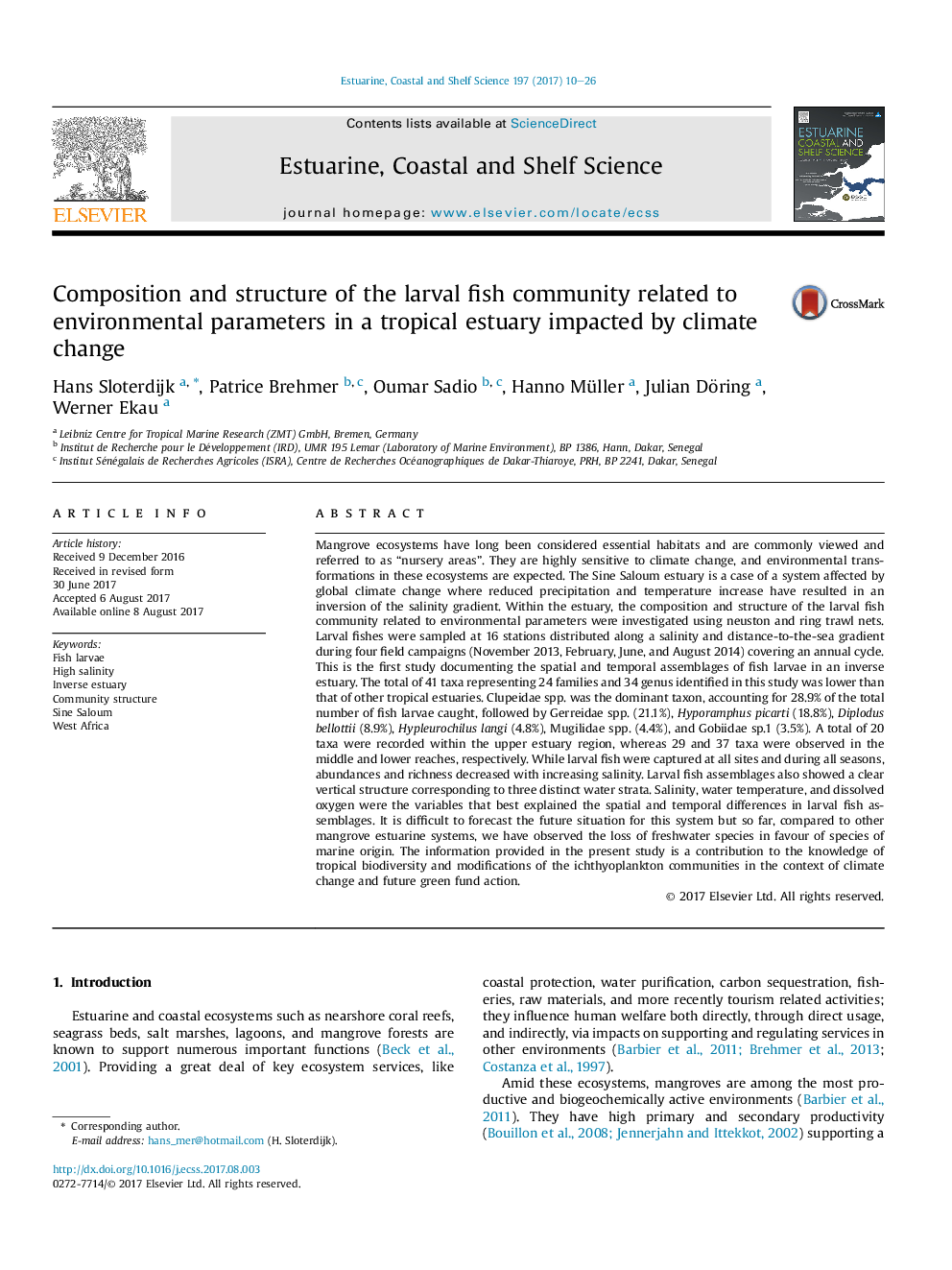| کد مقاله | کد نشریه | سال انتشار | مقاله انگلیسی | نسخه تمام متن |
|---|---|---|---|---|
| 5765054 | 1626605 | 2017 | 17 صفحه PDF | دانلود رایگان |
عنوان انگلیسی مقاله ISI
Composition and structure of the larval fish community related to environmental parameters in a tropical estuary impacted by climate change
ترجمه فارسی عنوان
ترکیب و ساختار جامعه ماهیان لاروی مرتبط با پارامترهای محیطی در یک رودخانه ی گرمسیری تحت تأثیر تغییرات آب و هوایی
دانلود مقاله + سفارش ترجمه
دانلود مقاله ISI انگلیسی
رایگان برای ایرانیان
کلمات کلیدی
لاروهای ماهی، شوری بالا، دریافت معکوس، ساختار جامعه، سینال سالوم، غرب آفریقا،
موضوعات مرتبط
مهندسی و علوم پایه
علوم زمین و سیارات
زمین شناسی
چکیده انگلیسی
Mangrove ecosystems have long been considered essential habitats and are commonly viewed and referred to as “nursery areas”. They are highly sensitive to climate change, and environmental transformations in these ecosystems are expected. The Sine Saloum estuary is a case of a system affected by global climate change where reduced precipitation and temperature increase have resulted in an inversion of the salinity gradient. Within the estuary, the composition and structure of the larval fish community related to environmental parameters were investigated using neuston and ring trawl nets. Larval fishes were sampled at 16 stations distributed along a salinity and distance-to-the-sea gradient during four field campaigns (November 2013, February, June, and August 2014) covering an annual cycle. This is the first study documenting the spatial and temporal assemblages of fish larvae in an inverse estuary. The total of 41 taxa representing 24 families and 34 genus identified in this study was lower than that of other tropical estuaries. Clupeidae spp. was the dominant taxon, accounting for 28.9% of the total number of fish larvae caught, followed by Gerreidae spp. (21.1%), Hyporamphus picarti (18.8%), Diplodus bellottii (8.9%), Hypleurochilus langi (4.8%), Mugilidae spp. (4.4%), and Gobiidae sp.1 (3.5%). A total of 20 taxa were recorded within the upper estuary region, whereas 29 and 37 taxa were observed in the middle and lower reaches, respectively. While larval fish were captured at all sites and during all seasons, abundances and richness decreased with increasing salinity. Larval fish assemblages also showed a clear vertical structure corresponding to three distinct water strata. Salinity, water temperature, and dissolved oxygen were the variables that best explained the spatial and temporal differences in larval fish assemblages. It is difficult to forecast the future situation for this system but so far, compared to other mangrove estuarine systems, we have observed the loss of freshwater species in favour of species of marine origin. The information provided in the present study is a contribution to the knowledge of tropical biodiversity and modifications of the ichthyoplankton communities in the context of climate change and future green fund action.
ناشر
Database: Elsevier - ScienceDirect (ساینس دایرکت)
Journal: Estuarine, Coastal and Shelf Science - Volume 197, 15 October 2017, Pages 10-26
Journal: Estuarine, Coastal and Shelf Science - Volume 197, 15 October 2017, Pages 10-26
نویسندگان
Hans Sloterdijk, Patrice Brehmer, Oumar Sadio, Hanno Müller, Julian Döring, Werner Ekau,
